An Advocate’s Perspective: Empower Mesothelioma Patients With Data-Based Hope
In early 2008, our firm wrote an article laying out the choices and difficulties faced by newly diagnosed mesothelioma patients. We suggested that patients need more data and more hard information from surgeons and oncologists regarding options. We also laid out the differences in reported survival times for the two major surgical options, the pleurectomy/decortication (P/D) and extra-pleural pneumonectomy (EPP).
Roger was subsequently invited to make a presentation to the International Mesothelioma Interest Group’s annual congress in Amsterdam on September 25, 2008.
His speech and PowerPoint presentation, which focused on funding for meso research and development of an online clinical database, are posted below. It was encouraging to hear so many surgeons throughout the world speak favorably about the pleurectomy/decortication (P/D) in terms of its survival averages, low surgical mortality, low rate of complications, recovery and quality of life.
One surgeon from the UK, where there is an ongoing randomized clinical trial comparing surgery (the EPP) to chemotherapy (Alimta/Cisplatin), questioned whether "the pain was worth the gain" with respect to the EPP. This surgeon, Dr. David Waller, announced that he favors the P/D over the EPP and advises that the ongoing trial (The MARS trial) allows patients selected for the surgical arm of the clinical trial to choose between an EPP or the P/D. More on that to come.
Note that on the West Coast the only thoracic surgeon who has consistently performed the pleurectomy/decortication for mesothelioma patients the past 15 years is Dr. Robert Cameron in Los Angeles.
IMIG Speech, Amsterdam, Sept. 26, 2008
In 1988, when I first began representing asbestos victims, the prevailing view amongst my Hobsian brethren was that mesothelioma was short-lived, brutish, nasty and incurable. I had no trouble accepting this. My first client was a young shipyard worker who had a tumor shooting out about 8 inches from under his right rib cage. I could barely look at him without tearing up.
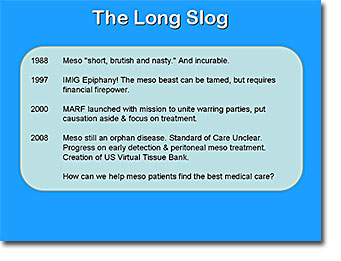
Then in 1997, I went to an IMIG conference in Philadelphia. For the first time, I heard the world’s top medical experts talking robustly about new and exciting strategies for actually taming this ugly beast.
I was energized, but appalled. You had great ideas, but basically you – the research community -- were broke. I was appalled because we’d known about asbestos disease since the early 1900’s and meso since the 1940’s. Asbestos had already killed hundreds of thousands of people worldwide. Millions more were living with asbestos fibers festering in their lungs. Billions of dollars had been spent on litigation. And yet no serious effort had ever been undertaken in the U.S. to prevent, detect, treat or cure asbestos cancer.
The asbestos epidemic in the U.S. had been packaged as a “trial lawyer problem” or a “bankruptcy problem,” but it wasn't a public health problem . In 1999, Harvey Pass, Bob Cameron and I decided to build a foundation – MARF-- that would finally focus on basic and applied research. We invited the asbestos industry (in our idealistic naivete), the drug companies, patients, and advocates to put aside our disagreements on causation and aim our guns at the common enemy, the tumor itself.
Today, despite some progress, meso is still an underfunded, orphan disease. We still don’t know what the best treatments are. We don’t know what the best surgery is, if any, or the best chemotherapy, if any, or the best combination of therapies. Effective pain management remains elusive. We’ve gained some ground on early detection and peritoneal meso patients are living much longer thanks to advances in multi-modal therapies.
But we still don’t have the weapons, or the warchest, we need to convert pleural meso into a chronic, treatable disease, like diabetes or high blood pressure.
In my work, I see the impact of this agonizingly slow progress every day. When newly diagnosed patients and their families contact my office, their first priority is to find the best treatment. Their second priority is to get the compensation to pay for those treatments and take care of their loved ones. They’ve usually done enough research to know two things: it’s not clear what their best move is but they better move fast.

I try to help my clients become smart shoppers. I want them to find the best doctors and best treatments which carry the best chance for them to stay alive longer.
I counsel them to ask tough questions. And they do. For example. They’re asking why surgeons tend to favor the radical pneumonectomy, even though there’s growing evidence that the pleurectomy/decortication has a longer median survival, with less surgical mortality and fewer complications, like atrial fibrillation. Plus, they get to keep their lung.
They want to know why doctors refer to the EPP as “curative” and the P/D as “palliative,” even though the goal of both is the removal of all visible tumor.
My clients are asking why Alimta/cisplatin has been anointed as the “standard of care.” They want to know why an oncologist, without recommending a surgical consult, would urge Alimta-cis as the “best, last and only hope” even though multimodal therapy has much better survival numbers.
My clients also want to know about pain management and quality of life issues. They want to talk to other patients and learn from their experience.
In sum, patients today are hungry for data-based hope.
But good, uncherry picked data are not readily available. So recently my law office sent out questionnaires to 40 or so thoracic surgeons in the US who treat meso patients. We targeted surgeons since surgery is the bedrock of any multi-modal treatment regimen, and surgeons are often regarded as the quarterback. My goal was simple: get the doctors to gather their numbers and allow me to post them on my website, comparing apples to apples, and let the patient-consumer decide.
As you can see, only 7 responded. Doctors Pass, Flores, Cameron, Rice and others had no problem displaying their results in the marketplace – in retrospect an act of courage and candor for which I’m sure confused and bereft patients are grateful.
But this experience got me to thinking. Why do some doctors tout the virtues of collaboration but keep their data private? Why are there so few surgeons who treat this disease? Why do so few publish? Why are the words “asbestos” and “mesothelioma” considered radioactive by some doctors? And why in the U.S. is there so little interest in research and why are doctors so reluctant to advocate?
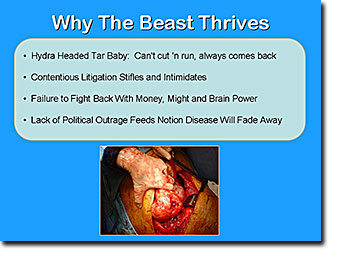
First, in my view, meso is like a hybridized hydra-headed tar baby. Surgeons can’t just cut and run. It sucks you in and dominates your practice. Clean margins are impossible – the tumor always comes back. It’s difficult and expensive to track and treat patients from start to finish. Whether an EPP or PD it’s a long and arduous surgery. In the time it takes to do one 10 hour PD, a surgeon could perform 7 breast implants and 3 liposuctions, make a lot more money, and have a social life.
Second, doctors don’t want to get dragged into litigation. This is understandable. The asbestos industry has a history of distorting the literature, silencing critics, and corrupting science. Industry has spent millions hiring medical mercenaries whose job is to manufacture doubt and discredit scientists who report on the connection between asbestos, disease and death.
Third, on top of the threat of personal and career attacks, there’s simply not much government or private R&D money available for research, unlike AIDS or bioterrorism. There’s plenty of data out there, but there’s never been the money or the will to capture it, organize it and make it accessible for research.
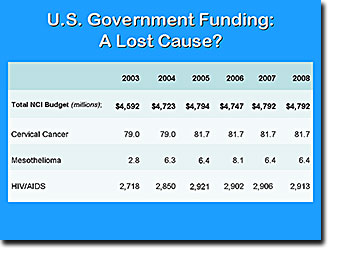
And fourth, there’s a lack of political outrage. Those who are responsible for unleashing and feeding this beast have never fully been held to account. This lack of outrage, in my view, has fed the notion that in a short time this disease will simply fade away -- a notion which has undercut the push for any long term research.
This apathy is reflected in our budget priorities. The NCI budget for meso actually dropped 20% this year to a paltry $6.4 million from a trivial high of $8.1 million. By way of comparison, cervical cancer and meso have about the same incidence, but cervical cancer was funded in an amount 10 times greater than meso.
Against this backdrop of apathy and neglect, the asbestos industry has invested billions of dollars to avoid liability.
Since the late 1960’s, $90 - 100B has been consumed in the legal arena. More than half has gone to transaction costs, like attorney fees and hired gun medical experts. Only 42% has found its way to the victims.
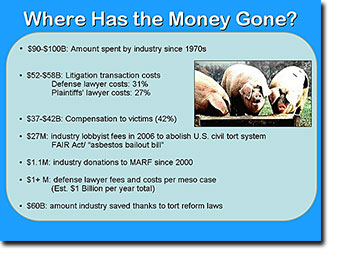
A few years ago the bean counters predicted industry would spend another $200 to $250 billion on litigation. But a well-funded anti-lawsuit crusade yielded new laws that have driven down the number of cases filed and capped damages at nominal levels. As a result, industry is predicted to save about $60 billion.
Has industry plowed their huge savings back into cleaning up their mess? Have they invested their windfall in medical research? Of course not. Instead, they’ve poured more money into hiring more medical mercenaries to churn out more junk science designed to give them more protection from being held responsible for the people they’ve hurt.
In eight years, the industry has donated about $1.1 million to MARF, the only non-profit that offers treatment-oriented research grants. $1.1 million, by an industry whose aggregate value is in the mega billions.
There are more than 1,000 meso lawsuits filed in the U.S. every year. In each lawsuit, defense lawyers together will bill out over $1.1 million in legal fees. That adds up to about a billion dollars every year to deny or shift the legal blame rather than fix the underlying health problem.
In short, this leviathan litigation has sucked the life out of research initiatives. Millions that could’ve been invested decades ago in finding a cure have been squandered on spin doctors, lobbyists and corporate lawyers. When I helped form MARF, I thought industry might take seriously their moral duty to clean up their mess. We were wrong. In many states, the law limits the recovery of an estate at an arbitrarily low number if the meso litigant should die before his case is resolved at trial. It turns out, perversely enough, that industry has an economic interest in hastening the demise of a meso plaintiff, as the compensation they’d pay a widow is a lot less than what they’d pay if her husband was alive.
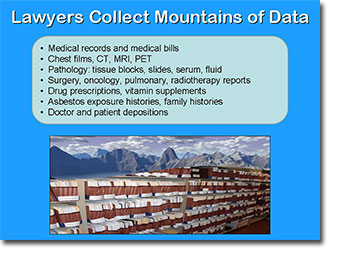
We need to turn back the clock and start doing today what we should’ve been doing all along – collecting clinical data and making it available for research.
Here’s how trial lawyers can help. We collect and we generate mountains of medical records. After our case is finished, the data just sit on computer servers or it’s boxed up and sent to storage. We’re talking about around 1,500 meso cases per year. Records, slides, tissue, fluid – the whole shebang.
The software exists to create a confidential, internet based database in which we can easily upload medical records. The data fields can be customized with logical, intuitive interfaces that make it simple for computer naïve patients to use.
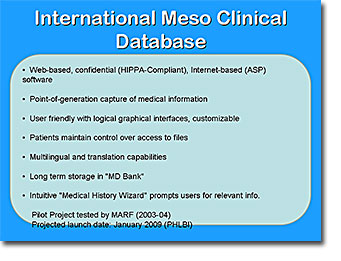
From anywhere in the world where internet access is available, patients themselves would be able to log in and upload data on their symptoms, such as pain, appetite, weight loss, shortness of breath, depression, and other clinical factors.
Similar patient-friendly databases have been set up for other tumors. In the US, we now have a Virtual Tissue Bank. All that’s needed to complete the research “circle of life” or “holy grail” is a clinical database that reaches out to the patients directly.
Several years ago MARF help fund a clinical database pilot project. My firm donated records for 350 patients to that effort. The project showed promise but the medical community did not cooperate, citing a lack of funding. Since then, the same engineers have continued to tinker with the software, making it much easier and more affordable to use. It should be ready to launch in early 2009.
How are we going to fund this database and the research projects it’s expected to generate?
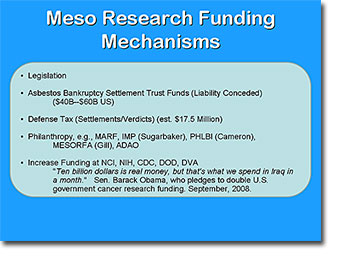
Simply put, the U.S. Congress needs to finally get in the game and start treating meso as a public health crisis. Trial Lawyers and victims shouldn’t be forced to solve a public health disaster that was started by industry, stoked by an apathetic US government and ignored by the drug companies. An ad hoc approach simply won’t work. The US Government needs to pass legislation to fund research now, and fund it generously.
Over a few Belgian Ales I can share with you my dreams of how to raise real money – they involve 1) setting aside a fraction of the billions of dollars in asbestos settlement trusts, 2) adding a tax to settlements to be paid for by the wrongdoer, and 3) the voluntary transfer of a percentage of settlements by plaintiffs and their lawyer.
A few closing remarks about how trial lawyers, doctors and patients can help each other
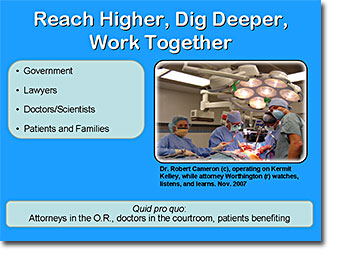
We lawyers need to expand the scope of our advocacy. We need to help drive research, educate our clients about the best treatment options, and make theirsurvival our priority. We need to continue to give money to research (thank the David and the Kazan law firms for sponsoring this event). We need to urge our clients to participate in a clinical data base. We need to donateour client’s medical records. And we need to refer our clients to those doctors who participate in the database, who publish their results, and who offer protocols that promise the best chance for a longer life.
Doctors need to step up, too. You need to faithfully record and share clinical data. You need to tell your patients frankly what you know and what you don’t know. As a wise surgeon recently reminded me: "Honesty need not be brutal and may be kinder than deceit." If the data show that the PD is superior to the radical EPP, but surgeons shy away from it because it takes longer but fetches a lower fee, then you need to re-adjust your billing rates to reflect the value of your extraordinarily skilled labor.
Just as we lawyers need to inform our clients of treatment options, doctors need to support their patient’s pursuit of compensation. As we make more progress and patients live longer, they will need more money to pay for their treatments, travel and so on.
Doctors also need to shed their reluctance to advocate. You need to help educate judges, juries and legislators about how savage this tumor is, and how it can strike anyone who has inhaled asbestos, how it was totally preventable, how it’s very expensive to treat, and how, with the right mix of money, courage and brain power, meso can one day be controlled, like HIV.
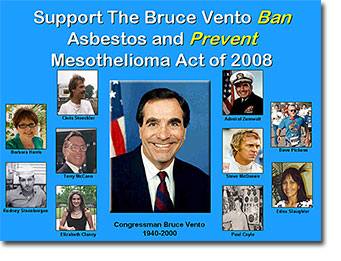
With a clinical database, properly interpreted by biostatisticians, patients will finally be able to choose doctors and therapies based on real data, not salesmanship or hype. As active participants in the generation of data, they will play a key role in their own survival. And, in my experience, patients who feel empowered and respected will give back to research generously.
[Yes, the gold standard for determining the best options is a randomized clinical trial, but in the U.S. its doubtful both patients and doctors will push for this – we’ll stand by and wait for the results in the UK ‘MARS” trial, even though now the architects of that trial concede that the surgery arm should include the P/D in addition to the EPP, if at all).
Finally, I’m an advocate, so permit me to make this challenge. IMIG is respected worldwide as the leading body of doctors and scientists who care about mesothelioma. You inspired me in 1997 to rally the troops to raise money for research. Today, I’m encouraging IMIG to stand up for meso patients and join up with other prominent scientific groups by adding your voice to the call for a universal ban on all types of asbestos.
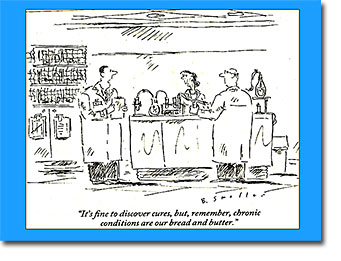
This is especially important in the US, where asbestos has not been banned, and in Canada, which continues to be a leading exporter of asbestos. The time is long over due to put an end to the canard that chrysotile is safe. Only when all forms of asbestos are banned will we finally be able to focus on treatment and prevention. The title of the bill now pending in the US Congress, ie, “The Bruce Vento Ban Asbestos and Prevent Mesothelioma Act of 2008,” reinforces this simple but profound connection, and I urge you to support it.
Finally, here’s a little teaser to any entrepreneurs out there from Big Pharma. There’s millions of fiber infested people out there. The only surefire way to cure meso is by preventing it in the first place.
Thank You.
Roger G. Worthington
rworthington@rgwpc.com
800-831-9399

